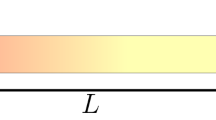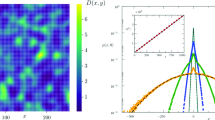Abstract
Let {X t:≥0} denote random walk in the random waiting time model, i.e., simple random walk with jump ratew −1(X t), where {w(x):x∈ℤd} is an i.i.d. random field. We show that (under some mild conditions) theintermediate scattering function F(q,t)=E 0 \(e^{iqX_l } \) (q∈ℝd) is completely monotonic int (E 0 denotes double expectation w.r.t. walk and field). We also show that thedynamic structure factor S(q, w)=2∫ ∞0 cos(ωt)F(q, t) exists for ω≠0 and is strictly positive. Ind=1, 2 it diverges as 1/|ω|1/2, resp. −ln(|ω|), in the limit ω→0; ind≥3 its limit value is strictly larger than expected from hydrodynamics. This and further results support the conclusion that the hydrodynamic region is limited to smallq and small ω such that |ω|≫D |q|2, whereD is the diffusion constant.
Similar content being viewed by others
References
L. Van Hove, Correlations in space and time and Born approximation scattering in systems of interacting particles,Phys. Rev. 95:249–262 (1954).
G. H. Vineyard, Scattering of slow neutrons by a liquid,Phys. Rev. 110:999–1010 (1958).
K. Sköld, J. M. Rowe, G. Ostrowski, and P. D. Randolph, Coherent- and incoherent-scattering laws of liquid argon,Phys. Rev. A 6:1107–1131 (1972).
P. E. Egelstaff,Introduction to the Liquid State (Academic Press, New York, 1967).
B. J. Alder and T. E. Wainwright, Velocity autocorrelations for hard spheres,Phys. Rev. Lett. 18:988–990 (1967); Decay of the velocity autocorrelation function,Phys. Rev. A 1:18–21 (1970).
W. Montfrooij and I. de Schepper, Velocity autocorrelation function of simple dense fluids from neutron scattering experiments.Phys. Rev. A 39:2731–2733 (1989).
P. Denteneer and M. H. Ernst, Diffusion in systems with static disorder,Phys. Rev. B 29:1755–1768 (1989).
F. den Hollander, J. Naudts, and F. Redig, Long-time tails in a random diffusion model,J. Stat. Phys. 69:731–762 (1992).
D. Forster,Hydrodynamic Fluctuations, Broken Symmetry and Correlation Functions (Benjamin, London, 1975).
J. P. Boon and S. Yip,Molecular Hydrodynamics (McGraw-Hill, New York, 1980).
H. Spohn,Large Scale Dynamics of Interacting Particle Systems (Springer, Berlin, 1991).
D. V. Widder,The Laplace Transform (Princeton University Press, Princeton, New Jersey, 1941).
C. Kipnis and S. R. S. Varadhan, Central limit theorem for additive functionals of reversible Markov processes and applications to simple exclusion,Commun. Math. Phys. 104:1–19 (1986).
A. De Masi, P. A. Ferrari, S. Goldstein, and D. W. Wick, An invariance principle for reversible Markov processes. Applications to random motions in random environments,J. Stat. Phys. 55:787–855 (1989).
G. Doetsch,Handbuch der Laplace-Transformation, Vol. 1 (Birkhauser, Basel, 1971).
N. H. Bingham, C. M. Goldie, and J. L. Teugels,Regular Variation (Cambridge University Press, Cambridge, 1987).
Author information
Authors and Affiliations
Rights and permissions
About this article
Cite this article
den Hollander, F., Naudts, J. & Redig, F. Dynamic structure factor in a random diffusion model. J Stat Phys 76, 1267–1285 (1994). https://doi.org/10.1007/BF02187062
Received:
Issue Date:
DOI: https://doi.org/10.1007/BF02187062




